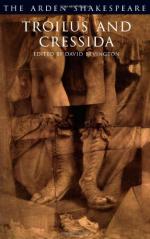|
This section contains 5,701 words (approx. 20 pages at 300 words per page) |

|
SOURCE: “In Defense of Cressida: Character As Metaphor,” in Women's Studies, Vol. 7, No. 3, 1980, pp. 1-17.
In the following essay, Okerlund analyzes the reassessments of Troilus, Cressida, Ulysses, and Pandarus that have occurred continuously since Troilus and Cressida was first produced, and concludes that our final judgment of these characters should be that none is evil or good in his or her own right, but that all are embodiments of human nature.
Fashions in literary criticism change. Not only do the theoretical stances shift from the new criticism to contextualism to Freudianism to historicism to formalism to Marxism to the newly-heralded reader-response criticism (to restrict examples to only a few decades of the twentieth century), but the sense of the meaning, or achievement, of an individual literary work can change just as dramatically. Perhaps no work better illustrates this critical reality than Shakespeare's Troilus and Cressida. Until well into...
|
This section contains 5,701 words (approx. 20 pages at 300 words per page) |

|


